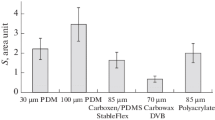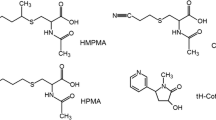Summary
Methyl chloride is used as a methylating agent and as a blowing agent in industrial processes. Alkylating agents and other electrophilic compounds are often detoxified in the organism through conjugation with glutathione. Glutathione conjugates are generally excreted as mercapturic acids, cysteine conjugates, or other thioethers in urine.
Urine samples obtained from persons occupationally exposed to methyl chloride were examined for the presence of elevated thioether levels using a previously published non-selective procedure. No significant increases were detectable.
A new assay procedure was developed for the detection of methylthio compounds in urine. The method is based on alkaline hydrolysis of urine samples and subsequent gas chromatographic determination of methyl mercaptan in the headspace of acidified hydrolysates. By application of this method a greatly increased excretion of a methylthio compound in the urine of CH3Cl-exposed workers was shown. The compound was identified as S-methylcysteine.
A study of the urinary S-methylcysteine excretion in a group of workers during a seven-day shift revealed that two of six workers hardly excreted any S-methylcysteine after exposure to methyl chloride.
Similar content being viewed by others
References
Barnsley EA (1968) The metabolism of methyl methanesulphonate in the rat. Biochem J 106:18P
Bus JA (1978) Disposition of 14C-methyl chloride in Fisher 344 rats after inhalation exposure. Pharmacologist 20:214
Doorn R van, Bos RP, Leijdekkers Ch-M, Wagenaars-Zegers MAP, Theuws JLG, Henderson PTh (1979) Thioether concentration and mutagenicity of urine from cigarette smokers. Int Arch Occup Environ Health 43:159–166
Ellman GL (1959) Tissue sulfhydryl groups. Arch Biochem Biophys 82:70–77
Field TG, Gilbert JB (1966) Quantitation of methanethiol in aqueous solution by head space gas chromatography. Anal Chem 38:628–629
Gorter E, Graaff WC de (1955) Clinical diagnostics (in Dutch). Stenfert Kroese, Leiden, p 440
Hake CL, Stewart RD, Wu A, Forster HV, Newton PE (1977) Experimental human exposure to methyl chloride at industrial environmental levels. Abstracts of the sixteenth annual meeting of the Society of Occupational Toxicology. Toxicol Appl Pharmacol 41:198
Hansen H, Weaver NK, Venable FS (1953) Methyl chloride intoxication: report of 15 cases. Arch Ind Hyg Occup Med 8:328–334
Johnson MK (1966) Metabolism of iodomethane in rat. Biochem J 98:38–43
Jones AM (1942) Methyl chloride poisoning. Q J Med 41:29–43
Kellie AE, Wade AP (1957) 17-Oxo steroid analysis by gradient elution. Biochem J 66:196
Morgan A, Black A, Belcher PR (1970) The excretion in breath of some aliphatic halogenated hydrocarbons following administration by inhalation. Ann Occup Hyg 13:219–233
Redford-Ellis M, Gowenlock AH (1971 a) Studies on the reaction of chloromethane with human blood. Acta Pharmacol Toxicol (Copenh) 30:36–48
Redford-Ellis M, Gowenlock AH (1971 b) Studies on the reaction of chloromethane with preparations of liver, brain, and kidney. Acta Pharmacol Toxicol (Copenh) 30:49–58
Simmon VF, Kauhanen K, Mortelmans K, Tardiff R (1978) Mutagenic activity of chemicals identified in drinking water. Mutat Res 53:129
Spevak L, Nadj V, Fellé D (1976) Methyl chloride poisoning in four members of a family. Br J Ind Med 33:272–278
Sujbert L (1967) Untersuchungen über den Abbau des Methylchlorids bei Mäusen. Arch Toxicol 22:233–235
Thomson AER, Barnsley EA, Young L (1963) Biochemical studies of toxic agents 14. The biosynthesis of ethylmercapturic acid. Biochem J 86:145–152
Thordarson O, Gudmundson G, Bjarnasson O, Johanesson T (1965) Methyl chloride poisoning (in Danish). Nord Med 73:150
Wood JL (1970) Biochemistry of mercapturic acid formation. In: Fishman WH (ed) Metabolic conjugation and metabolic hydrolysis. Academic Press, New York London, pp 261–300
Author information
Authors and Affiliations
Rights and permissions
About this article
Cite this article
van Doorn, R., Borm, P.J.A., Leijdekkers, C.M. et al. Detection and identification of S-methylcysteine in urine of workers exposed to methyl chloride. Int Arch Occup Environ Health 46, 99–109 (1980). https://doi.org/10.1007/BF00378189
Received:
Accepted:
Issue Date:
DOI: https://doi.org/10.1007/BF00378189




